
Lomatium is a genus in the family Apiaceae. It consists of about 100 species native to western Northern America and northern Mexico. Its common names include biscuitroot, Indian parsley, and desert parsley. It is in the family Apiaceae and therefore related to many familiar edible species such as carrots and celery; some Lomatium species are extensively used by Native Americans in the inland Northwest as a staple food.
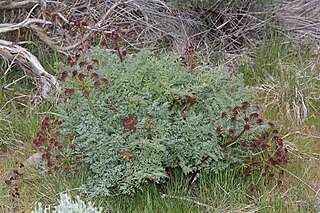
Lomatium dissectum is a species of flowering plant in the carrot family known by the common names fernleaf biscuitroot and fernleaf desert parsley. It is native to much of western North America, where it grows in varied habitat. It is found in the eastern slopes of the Cascade Range, Rocky Mountains, Klamath Mountains, eastern Transverse Ranges and the Sierra Nevada in California.
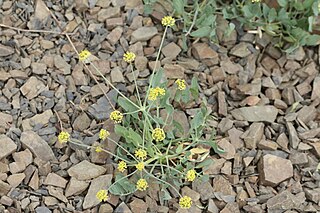
Lomatium nudicaule is a species of flowering plant in the carrot family known by the common names pestle lomatium, barestem biscuitroot, Indian celery and Indian consumption plant. It is native to western North America from British Columbia to California to Utah, where it is known from several habitat types, including forest and woodland. It is a perennial herb growing up to about 70 centimetres (28 in) tall from a thick taproot. It generally lacks a stem, the inflorescence and leaves emerging from ground level. The leaves are made up of many dull green, waxy lance-shaped leaflets each up to 9 cm long. The inflorescence is borne on a stout, leafless peduncle widening at the top where it blooms in an umbel of yellow or purplish flowers.
The Agate Desert is a prairie located near White City, Oregon, 53 acres (21 ha) of which is protected as the Agate Desert Preserve. The area is not in fact a desert as its name suggests; it is so named because of the abundance of agate, petrified wood, jasper, and other minerals found there. Much of the World War II army training base of Camp White was built in the Agate Desert. The Nature Conservancy is working to preserve the Agate Desert as a native Rogue River Valley grassland.

Lomatium roseanum, adobe parsley, also known as adobe lomatium and rose-flowered desert-parsley, is a very rare plant of the Western U.S., known only from northwestern Nevada and southeastern Oregon, and which may also occur in northeastern California. The largest populations occur on the Sheldon National Wildlife Refuge. It is a member of the celery family, the Umbelliferae, and has yellow flowers.

Lomatium bradshawii, also known as Bradshaw's desert parsley, is an endangered perennial herb native to Oregon and Washington, United States. Lomatium bradshawii was thought to be extinct until 1979, when it was rediscovered by a University of Oregon graduate. This herb was common in the Willamette Valley before agricultural development and fire prevention which has allowed shrubs and weeds to invade. Most known populations of Lomatium bradshawii are within ten miles of Eugene, Oregon. In the Willamette Valley, populations exist in the Oregon counties Lane, Benton, Linn, and Marion, and in Washington Lomatium bradshawii grows in Puget Sound. The largest population of this herb is in Camas Meadows, Washington, with a population of 10,7900,00 +/- 2,010,000, and the Berry Botanic Garden keeps a seedbank.

Lomatium salmoniflorum is a perennial herb native to the northwest United States. In February and March one to nineteen umbels bloom, each with up to 300 flowers. Each flower is either strictly staminate or hermaphroditic. It has glabrous leaves that are deeply dissected into narrow blades.

Lomatium brandegeei, also known as Brandegee's desert-parsley is a perennial herb of the family Apiaceae that grows in northern Washington and into British Columbia. Compound umbels with yellow flowers appear from May to June. It has a relatively short taproot, and its stems are 20–60 cm tall.

Lomatium columbianum is a perennial herb of the family Apiaceae known by the common names purple leptotaenia and Columbia desert parsley. It is endemic to the U.S. states of Oregon and Washington, mostly along the Columbia River east of the Cascades.

Lomatium cuspidatum is a perennial herb of the family Apiaceae, native to the U.S. state of Washington. It is found primarily on open rocky slopes in the Wenatchee Mountains, strongly associated with serpentine scree and soils.

Lomatium foeniculaceum is a species of flowering plant in the carrot family known by the common name desert biscuitroot. It is native to much of western and central North America, where it grows in many types of habitat.

Lomatium grayi, commonly known as Gray's biscuitroot, Gray's desert parsley, or pungent desert parsley, is a perennial herb of the family Apiaceae. It is native to Western Canada in British Columbia, and the Western United States, including from the Eastern Cascades and northeastern California to the Rocky Mountains.

Lomatium mohavense is a species of flowering plant in the carrot family known by the common name Mojave desertparsley. It is native to southern California with a few outlying populations in Arizona, Nevada and Baja California. It is found in several types of mountain and desert habitat, including chaparral, woodland, and scrub, mostly from 2,000–7,000 feet (600–2,100 m) elevation.
Lomatium ravenii is a species of flowering plant in the carrot family known by the common names Lassen parsley and Raven's lomatium. It is native to the Great Basin of the United States, where it grows in sagebrush and other plateau habitat, including areas with somewhat alkaline soils in Nevada, California, and other states.
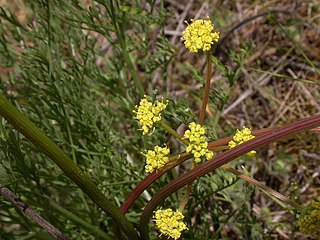
Lomatium cookii is a rare species of flowering plant in the carrot family known by the common names Cook's lomatium and agate desertparsley. It is endemic to Oregon in the United States, where it grows in only two valleys. It is a federally listed endangered species.
Lomatium papilioniferum is a species of Lomatium previously included in the Lomatium grayi complex. It is native from southern British Columbia to northern California and east to Idaho and Nevada. It occurs in dry lowland areas including sagebrush desert.
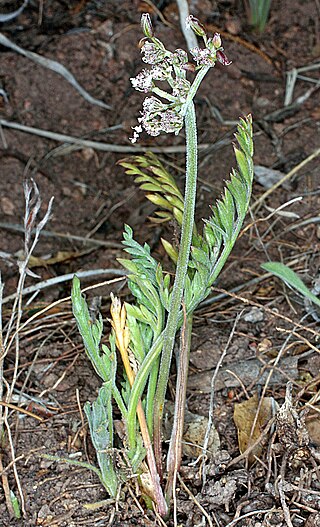
Lomatium orientale, commonly known as salt-and-pepper, eastern cous, eastern desert-parsley, eastern lomatium, white-flowered desert-parsley, oriental desert parsley or Northern Idaho biscuitroot, is a small spring blooming ephemeral plant. It grows in open habitats from the plains to foothills in western North America. It is known as one of the earliest blooming native flowers in its habitat. The species name, "orientale", is botanical Latin meaning "eastern".
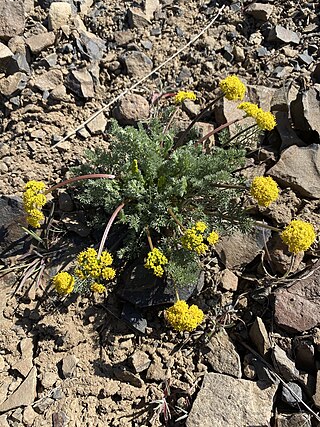
Lomatium quintuplex is a perennial herb in the carrot family Apiaceae, native to the U.S. state of Washington, and known by the common name Umtanum desertparsley. It grows in thin rocky soil on open slopes and is known only from a small region in Kittitas and Yakima counties.














